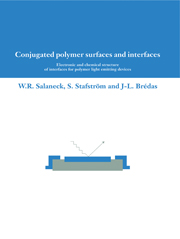 Conjugated Polymer Surfaces and Interfaces
Conjugated Polymer Surfaces and Interfaces Book contents
3 - Experimental methods
Published online by Cambridge University Press: 12 January 2010
Summary
Survey of measurement methods
Here we survey a series of possible surface-sensitive measurements which in principle can be used to study the surfaces of conjugated polymers and the early stages of metal interface formation. We then motivate the use of photoelectron spectroscopy.
NEXAFS, or near edge X-ray absorption fine-structure spectroscopy, is one method of particular interest, which provides both chemical and electronic information. NEXAFS, as photoelectron spectroscopy, is a photon-in-electron-out spectroscopy, and, therefore, surface sensitive. The basis for NEXAFS is carried out using polarized, monochromatized synchrotron radiation, which leads to sensitivity to molecular orientation, which can be of particular use in studying ordered polymer systems. Also, two electron probe methods should be mentioned. The first is high resolution low energy electron energy loss spectroscopy, HREELS. Generally somewhat destructive to organic surfaces, and fraught with serious electronic charging problems when used on electrically insulating organic surfaces, some success has been achieved with HREELS in special cases. Both electronic structure and vibrational information have been obtained by Pireaux and co-workers. Polarization effects are inherent, which can be important in studying ordered systems. The second method is that of high energy electron energy loss spectroscopy, which measures the momentum-dependent energy loss function. Information on the electronic transitions, as in optical spectroscopy, is obtained as a function of the momentum transfer within the electron scattering event. Free standing films of about 1000 Å thickness (or less) are required to minimize multiple scattering in transmission measurements. In addition, the equipment is very specialized and not available commercially.
- Type
- Chapter
- Information
- Conjugated Polymer Surfaces and InterfacesElectronic and Chemical Structure of Interfaces for Polymer Light Emitting Devices, pp. 33 - 49Publisher: Cambridge University PressPrint publication year: 1996


